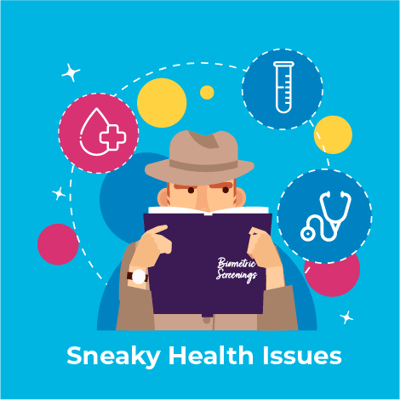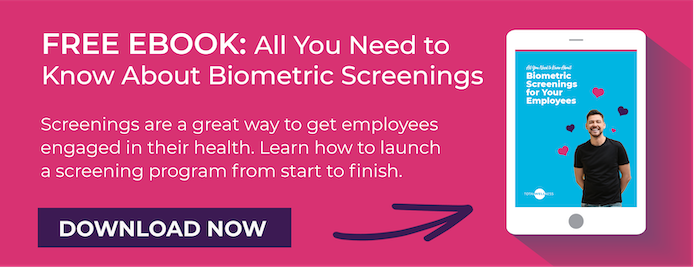 Health problems can be sneaky.
Health problems can be sneaky.
Sometimes, it isn’t until you feel that twinge in your chest or shortness of breath that you realize something is seriously wrong. In other cases, you may feel fine. Nothing shows up out of the ordinary until the doc runs bloodwork.
Like it or not, there are several health conditions that develop quietly with few — or zero — symptoms.
Luckily, biometric screenings may detect early warning signs so employees can address conditions before they become problematic. Even if you don’t host biometric screenings in your workplace, encouraging your employees to do their annual blood tests can save a life.
Here’s a look at three often symptomless conditions biometric screening results can detect:
Diabetes
Diabetes is a disease where a person has too much sugar in their blood. When you have diabetes, your body won’t or doesn’t use insulin well. Insulin is responsible for helping the glucose in your food move into the cells to provide your body with energy.
High blood sugar can lead to:
- Stroke
- Heart disease
- Kidney disease
- Eye problems
- Dental disease
- Nerve damage
- Foot problems
Unfortunately, over 30 million people in the U.S. live with diabetes, according to the Centers for Disease Control and Prevention. Of those millions, about 7.2 million are undiagnosed. The most common diabetes is Type 2. It’s also the seventh leading cause of death in the United States.
Diabetes can develop at any age, but it’s more likely for those who are 45 and older. If you’re overweight and inactive — or have a family history of diabetes — you may be at risk. High blood pressure can also be a factor. Biometric screenings test blood glucose levels, which can provide an early warning of developing diabetes.
Why it’s sneaky: There may or may not be symptoms. And the symptoms that do arise are common in many medical conditions. Potential symptoms are increased thirst, frequent urination, hunger, fatigue, blurred vision, changes in weight, and slow healing.
High Cholesterol
More than 100 million Americans have high cholesterol which can lead to stroke, heart attack, and/or blood clots. Cholesterol is a fat-like substance that can build up in arteries. This leads to limited blood flow or the formation of blood clots.
Risk factors for high cholesterol include:
- Diabetes
- Smoking
- High blood pressure
- Family history of heart disease or high cholesterol
Luckily, high cholesterol is treatable with lifestyle changes and medication. Biometric screenings, in particular, include a lipid panel that tests for cholesterol levels.
Why it’s sneaky: Unfortunately, there are no symptoms with high cholesterol. The only way to know your cholesterol levels is by testing.
High Blood Pressure
Known as the “silent killer,” high blood pressure impacts more than 80 million Americans, according to the American Heart Association. That’s one in three adults! What’s worse is that nearly half of these individuals don’t have it under their control.
While the exact cause isn’t known, contributing factors include:
- Stress
- Poor diet
- Smoking
- Genetics
- Older age
- Sedentary lifestyle
High blood pressure contributes to nearly 1,000 deaths a day.
Treatment includes medication and/or lifestyle changes to include diet and exercise. Regular biometric screenings provide blood pressure readings, so it can help you become familiar with your typical “numbers” when it comes to blood pressure.
Why it’s sneaky: Since it often has no symptoms, it isn’t until someone has a stroke, heart attack, or heart disease that they realize they have hypertension. High blood pressure is usually the main or secondary cause of 75% of strokes and heart attacks. Hypertension can also take years to develop. With testing, you may catch it during “pre-hypertension” and get it under control early.
What is a Health Screening? A Life-Saving Assessment
Why worry about sneaky health conditions? Left undetected, it could end life early.
Encourage your employees to get a screening done annually (or more often, if needed), to get ahead of preventable health issues. It provides answers long before the body decides to show symptoms, in most cases.
As an employer, you can help your workers be proactive by setting up annual biometric screenings onsite. Even if you don’t host them, just sending a friendly annual reminder is a great way to help them keep their health from spiraling out of control.
A simple health screening can be the difference between life and death for your employees.
If you want to encourage employee health and wellness, one way to start is with reminders for easy-to-do health screenings. Share 10 Health Screenings to Check Off Your Health To-Do List with employees today!
Want more content like this? Don’t forget to subscribe to our Employee Wellness Blog!



